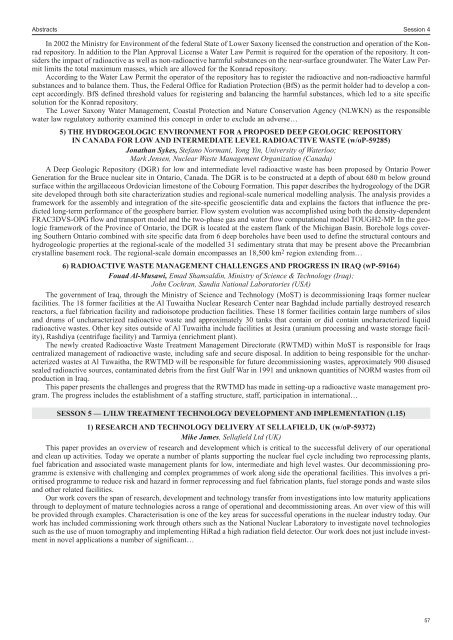ICEM11 Final Program 9.7.11pm_ICEM07 Final Program ... - Events
ICEM11 Final Program 9.7.11pm_ICEM07 Final Program ... - Events
ICEM11 Final Program 9.7.11pm_ICEM07 Final Program ... - Events
Create successful ePaper yourself
Turn your PDF publications into a flip-book with our unique Google optimized e-Paper software.
Abstracts Session 4<br />
In 2002 the Ministry for Environment of the federal State of Lower Saxony licensed the construction and operation of the Konrad<br />
repository. In addition to the Plan Approval License a Water Law Permit is required for the operation of the repository. It considers<br />
the impact of radioactive as well as non-radioactive harmful substances on the near-surface groundwater. The Water Law Permit<br />
limits the total maximum masses, which are allowed for the Konrad repository.<br />
According to the Water Law Permit the operator of the repository has to register the radioactive and non-radioactive harmful<br />
substances and to balance them. Thus, the Federal Office for Radiation Protection (BfS) as the permit holder had to develop a concept<br />
accordingly. BfS defined threshold values for registering and balancing the harmful substances, which led to a site specific<br />
solution for the Konrad repository.<br />
The Lower Saxony Water Management, Coastal Protection and Nature Conservation Agency (NLWKN) as the responsible<br />
water law regulatory authority examined this concept in order to exclude an adverse…<br />
5) THE HYDROGEOLOGIC ENVIRONMENT FOR A PROPOSED DEEP GEOLOGIC REPOSITORY<br />
IN CANADA FOR LOW AND INTERMEDIATE LEVEL RADIOACTIVE WASTE (w/oP-59285)<br />
Jonathan Sykes, Stefano Normani, Yong Yin, University of Waterloo;<br />
Mark Jensen, Nuclear Waste Management Organization (Canada)<br />
A Deep Geologic Repository (DGR) for low and intermediate level radioactive waste has been proposed by Ontario Power<br />
Generation for the Bruce nuclear site in Ontario, Canada. The DGR is to be constructed at a depth of about 680 m below ground<br />
surface within the argillaceous Ordovician limestone of the Cobourg Formation. This paper describes the hydrogeology of the DGR<br />
site developed through both site characterization studies and regional-scale numerical modelling analysis. The analysis provides a<br />
framework for the assembly and integration of the site-specific geoscientific data and explains the factors that influence the predicted<br />
long-term performance of the geosphere barrier. Flow system evolution was accomplished using both the density-dependent<br />
FRAC3DVS-OPG flow and transport model and the two-phase gas and water flow computational model TOUGH2-MP. In the geologic<br />
framework of the Province of Ontario, the DGR is located at the eastern flank of the Michigan Basin. Borehole logs covering<br />
Southern Ontario combined with site specific data from 6 deep boreholes have been used to define the structural contours and<br />
hydrogeologic properties at the regional-scale of the modelled 31 sedimentary strata that may be present above the Precambrian<br />
crystalline basement rock. The regional-scale domain encompasses an 18,500 km2 region extending from…<br />
6) RADIOACTIVE WASTE MANAGEMENT CHALLENGES AND PROGRESS IN IRAQ (wP-59164)<br />
Fouad Al-Musawi, Emad Shamsaldin, Ministry of Science & Technology (Iraq);<br />
John Cochran, Sandia National Laboratories (USA)<br />
The government of Iraq, through the Ministry of Science and Technology (MoST) is decommissioning Iraqs former nuclear<br />
facilities. The 18 former facilities at the Al Tuwaitha Nuclear Research Center near Baghdad include partially destroyed research<br />
reactors, a fuel fabrication facility and radioisotope production facilities. These 18 former facilities contain large numbers of silos<br />
and drums of uncharacterized radioactive waste and approximately 30 tanks that contain or did contain uncharacterized liquid<br />
radioactive wastes. Other key sites outside of Al Tuwaitha include facilities at Jesira (uranium processing and waste storage facility),<br />
Rashdiya (centrifuge facility) and Tarmiya (enrichment plant).<br />
The newly created Radioactive Waste Treatment Management Directorate (RWTMD) within MoST is responsible for Iraqs<br />
centralized management of radioactive waste, including safe and secure disposal. In addition to being responsible for the uncharacterized<br />
wastes at Al Tuwaitha, the RWTMD will be responsible for future decommissioning wastes, approximately 900 disused<br />
sealed radioactive sources, contaminated debris from the first Gulf War in 1991 and unknown quantities of NORM wastes from oil<br />
production in Iraq.<br />
This paper presents the challenges and progress that the RWTMD has made in setting-up a radioactive waste management program.<br />
The progress includes the establishment of a staffing structure, staff, participation in international…<br />
SESSON 5 — L/ILW TREATMENT TECHNOLOGY DEVELOPMENT AND IMPLEMENTATION (1.15)<br />
1) RESEARCH AND TECHNOLOGY DELIVERY AT SELLAFIELD, UK (w/oP-59372)<br />
Mike James, Sellafield Ltd (UK)<br />
This paper provides an overview of research and development which is critical to the successful delivery of our operational<br />
and clean up activities. Today we operate a number of plants supporting the nuclear fuel cycle including two reprocessing plants,<br />
fuel fabrication and associated waste management plants for low, intermediate and high level wastes. Our decommissioning programme<br />
is extensive with challenging and complex programmes of work along side the operational facilities. This involves a prioritised<br />
programme to reduce risk and hazard in former reprocessing and fuel fabrication plants, fuel storage ponds and waste silos<br />
and other related facilities.<br />
Our work covers the span of research, development and technology transfer from investigations into low maturity applications<br />
through to deployment of mature technologies across a range of operational and decommissioning areas. An over view of this will<br />
be provided through examples. Characterisation is one of the key areas for successful operations in the nuclear industry today. Our<br />
work has included commissioning work through others such as the National Nuclear Laboratory to investigate novel technologies<br />
such as the use of muon tomography and implementing HiRad a high radiation field detector. Our work does not just include investment<br />
in novel applications a number of significant…<br />
57
















